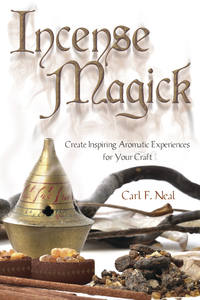As many of you know, incense is more than just nice-smelling smoke. It can be used to deepen meditation, cleanse bad energy, and drive away unwanted spirits. A powerful tool in ritual and self-change, it makes sense that many metaphysical shops carry this aromatic product.
Do customers ever ask questions about the incense you carry? This insightful article from Carl F. Neal, author of Incense and Incense Magick (a March 2012 release), explains some not-widely-known details about charcoal incense.
Incense Retailing Secrets: Charcoal
By Carl F. Neal
Two Kinds of Incense Charcoal
Charcoal is a commonly purchased incense product and one that presents a growing concern from consumers. Incense charcoal can generally be broken into two categories: those without saltpeter (potassium or sodium nitrate) and those that do include this ingredient. This is a concern to many customers because saltpeter gives off a bad odor, which can affect the smell of herbs, resins, or other types of incense. More importantly, the saltpeter is an oxidizer that increases the amount of heat produced by the charcoal. When charcoal burns hot, it will destroy the incense placed on it much faster.
Why Use Saltpeter?
So why include saltpeter in any charcoal? The saltpeter can make it easier to light this type of charcoal and keep it burning regardless of the quality of the wood that is used. There is a perception among some consumers that saltpeter is mandatory for charcoal to light easily.
Benefits of Low-Scent Charcoal
 |
| Incense Magick by Carl F. Neal |
Don’t forget to mention the lack of scent. That’s a strong selling point.
Incense Lighting Tips
Here are some tips for lighting charcoal that does not contain saltpeter:
- Light charcoal over a candle flame rather than attempting to use a butane lighter.
- Use metal tongs to hold the charcoal so you don’t scorch fingers.
- Allow the charcoal to sit after lighting until the entire brick is covered with a layer of fine ash.
Distinguishing Low-Scent Charcoal from Types Containing Saltpeter
So which types do you sell? If any of your charcoal is labeled “self-lighting” or if it sparks and sputters when initially lit, then this charcoal includes saltpeter. This type of charcoal is often sold in rolls of round charcoal bricks wrapped in foil or plastic. Many brands of this style come from India. Ounce-for-ounce, it is usually less expensive than other types of charcoal.
Low-scent charcoal generally comes from Japanese and Chinese suppliers. The bricks can be square, rectangular, or even (usually in the formal style for the “kodo ceremony”) cylindrical in form. Some brands are covered in paper to prevent charcoal dust from transferring to the user’s fingers. I am unaware of any low-scent charcoal that is sold in rolls, but there may be some brands out there that are. Low-scent charcoal is available from a number of wholesale suppliers in the USA and Europe.
Incense Displays
In just a few inches of display area, you can illustrate how each type of charcoal is best used and a comparison between the two. These types of displays have historically made dramatic improvements in the sales of charcoal, censers/burners, and incense.
Knowing your products and having ready answers for your customers will improve your sales and build confidence in your customer base. Educating your staff will allow everyone to provide consistent advice and guidance.
Smells like a great approach to me!
***
Carl F. Neal is the author of Incense and his new book Incense Magick will be released this March. He has been a student of incense since 1977. In 1995, he became a professional incense maker and has avidly researched incense ever since. He has been lucky enough to learn from a variety of incense makers from North and South America, Asia, and Europe.
Carl leads incense workshops and discussions across the country and loves teaching about incense at all sorts of community events. Visit his website.



Hi all,
ReplyDeleteHave a nice day.
spices of madurai